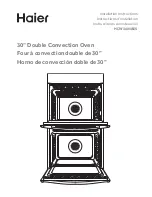
28
Food characteristics &
Microwave cooking
Stirring
Stirring is one of the most important of all microwaving techniques. In conventional cooking,
food is stirred for the purpose of blending. Food cooked in microwave oven, however, is
stirred in order to spread and redistribute heat evenly. Always stir from the outside towards
the centre as the outside of the food heats first.
Turning over
Large, tall foods such as roasts and whole chickens should be turned so that the top and
bottom will cook evenly. It is also a good idea to turn cut up chicken pieces and chops.
Placing thicker portions facing outwards
Microwaves cook the outer portion of food; hence, place thicker portions of meat, poultry
and fish at the outer edge of the cooking dish. this way, thicker portions will receive the most
microwave energy and the food can get cooked evenly.
Shielding
Use small, flat pieces of aluminum foil to shield the thin pieces or corners of food. Do not
use too much foil and make sure foil does not touch the walls of oven to avoid arcing.
Elevating
Thick or dense foods should be elevated so that microwaves can be absorbed by the
bottom and centre of the food.
Piercing
Foods enclosed in a shell, skin or membrane; are likely to burst in the oven unless they are
pierced prior to cooking. Such foods include yolks and eggs whites, clams and oysters and
whole vegetables and fruits.
Testing if cooked
Food cooks more quickly in a microwave oven, it is necessary to check it frequently. Some
foods are left in the microwave until it is completely cooked. But most foods, including meats
and poultry, are removed from the oven while it is still slightly undercooked and finished
cooking during standing time. The internal temperature of foods will rise between 5˚F (3˚C)
and 15
˚
F (8
˚
C) during standing time.
Standing time
Foods are often stood for 3 to 10 minutes after being removed from the microwave oven.
Usually the foods are covered during standing time to retain heat unless they are supposed
to be dry in texture (some cakes and biscuits, for example). Standing allows foods to finish
cooking and also helps to develop and blend flavour.
To Clean Your Oven
1 Keep the inside of the oven clean
It is recommended to clean up spill over and crumbs with damp cloth immediately.
Use a damp cloth to wipe away crumbs that fall between the door and the door
frame. Spill over and crumbs will absorb microwave energy and lengthen cooking
time. It is important there is no crumbs stick to the door and door frame to ensure
the door can close tightly. Remove greasy spatters with a soft soapy cloth, then wipe
with clean water and wipe dry. Do not use harsh detergent or abrasive cleaners.
The glass tray can be washed by hand or in the dishwasher.
2 Keep the outside of the oven clean
Clean the outside of your oven with a soft soapy cloth, then wipe with clean water
3
and wipe dry. Do not let water seep into the ventilation openings. Open the door when
If steam accumulates inside or around the outside of the oven door, wipe the panels
cleaning the control panel. This is to prevent accidental running of the oven. After
cleaning, press
STOP/CLEAR
key.
with a soft cloth. This may occur when the microwave oven is operated under high
humidity conditions and in no way indicates a malfunction of the unit.
4
The door and door seals should be kept clean. Use only warm soapy water to clean
first, wipe clean with clean water and wipe dry thoroughly.
DO NOT USE ABRASIVE MATERIALS, SUCH AS CLEANING POWDERS OR STEEL
OR PLASTIC PADS.
It is recommended to clean the oven regularly.
Содержание MS-2347AR
Страница 1: ...MICROWAVE OVEN OWNER S MANUAL PLEASE READ THIS OWNER S MANUAL THOROUGHLY BEFORE OPERATING MS 2357AR ...
Страница 7: ...L ...
Страница 8: ......
Страница 10: ......
Страница 12: ......
Страница 14: ......
Страница 16: ......
Страница 18: ......
Страница 31: ...P No MFL3777101 ...




































